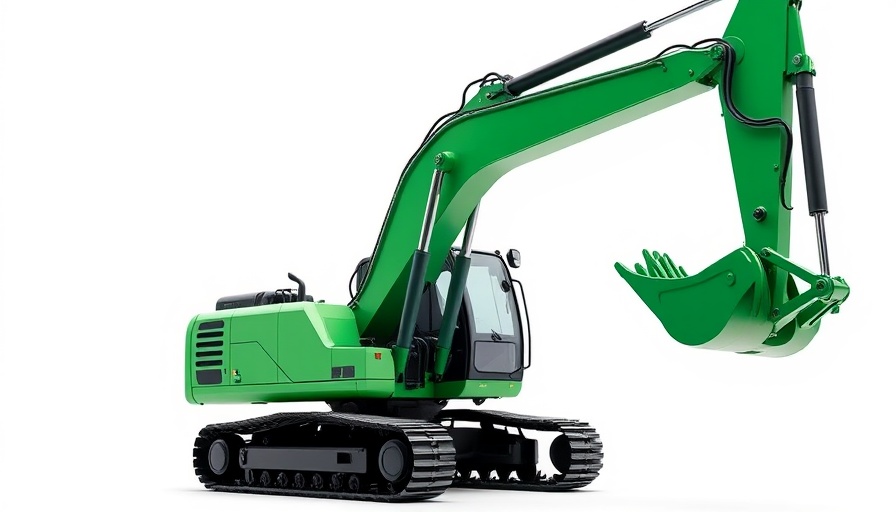
Revolutionizing Heavy Machinery: The Electric Future
XCMG has made impressive strides in the construction industry with its latest innovation—the XE215EV, a 25-ton electric excavator equipped with advanced battery-swapping technology. Debuting to much fanfare at Bauma, this excavator is not just another piece of heavy equipment; it represents a significant leap toward greener construction practices. With electrification becoming a vital focus in numerous industries, the XE215EV sets a new benchmark for efficiency, sustainability, and technological advancement.
Fast Charging and Battery Swapping: Designed for Efficiency
The heart of the XE215EV is its 400 kWh lithium-iron phosphate battery. What stands out is its dual-gun DC fast charging capabilities that can fully recharge the battery in just 1.5 hours. Additionally, the excavator can swap out battery packs in merely three minutes—a game changer that allows operators to minimize downtime effectively. This innovative approach makes operating the XE215EV as efficient as traditional diesel machines, while also dramatically reducing operational costs by approximately 60%.
Superior Performance Under Extreme Conditions
One of the key advantages of the XE215EV's battery packs is their robust design. Developed in partnership with BYD, the Blade battery system can withstand extreme temperatures from -40 to 149 degrees Fahrenheit and altitudes above 18,000 feet, ensuring reliability in various working environments. This kind of resilience is crucial for construction projects in harsh conditions, allowing for improved operational continuity no matter where the job site may be.
Compact Yet Powerful: Tailored for Urban Job Sites
Engineered for versatility, the XE215EV's compact design enables it to work in confined spaces such as urban job sites, mines, cargo yards, and tunnels. Featuring a high-torque permanent magnet synchronous motor rated at 160 horsepower, this electric excavator also incorporates a strengthened turntable and optimized boom and dipper rod. The result? A multifaceted machine adept at various tasks, reducing the need for multiple pieces of equipment.
The Operator's Experience: Comfort Meets Technology
XCMG has not overlooked operator comfort in the design of the XE215EV. Equipped with a pressurized cab, operators can enjoy a 10-inch touchscreen display that integrates all necessary controls and a heated air-suspension seat for a comfortable working environment. High-definition cameras provide a complete 360-degree view around the excavator, enhancing safety and operational efficiency. This thoughtful design reflects the company's commitment to improving the overall experience for operators while promoting productivity.
The Green Revolution in Construction Equipment
XCMG is dedicated to contributing to a sustainable future through its green innovations. The company's ambitions extend beyond the XE215EV, with 19% of its current product portfolio falling under their 'Green Mountain' new energy line. The commitment to full electrification across all series is not just a goal but a clear signal of where the construction industry is headed in the coming years. As environmentally friendly solutions become more critical, XCMG is positioning itself as a leader in this transition.
Practical Insights for Contractors
This breakthrough in electric machinery not only enhances productivity but also aligns with growing demands for sustainability among contractors and project owners. Contractors considering adopting this electric excavator can benefit from cost-efficiencies and reduced environmental impacts associated with operating diesel equipment. In a time where regulators and clients are increasingly favoring green solutions, investing in machines like the XE215EV may position contractors favorably for future projects.
Conclusion: The Need for Change in the Industry
As the construction industry evolves, embracing electric equipment seems to be an essential step towards a more sustainable future. With machines like the XE215EV, expectations for efficiency, productivity, and environmental responsibility are being transformed. As contractors and homeowners alike seek innovative solutions that balance fiscal responsibilities with ecological concerns, XCMG's electric excavator highlights the path forward in construction equipment.
As we move towards embracing more sustainable practices, the electric excavator from XCMG could be a game-changer for contractors looking to modernize their operations. Consider how adopting such innovative technology can elevate your business and meet the emerging demands of green construction.
 Add Row
Add Row  Add
Add 




Write A Comment